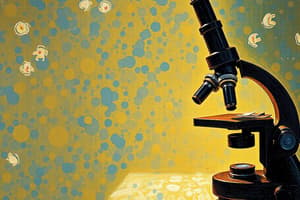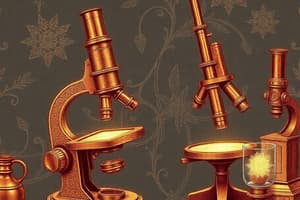Podcast
Questions and Answers
What is a simple microscope?
What is a simple microscope?
It's a single lens microscope that provides small magnifications.
Which of the following microscopes uses two lenses to magnify objects?
Which of the following microscopes uses two lenses to magnify objects?
- Electron Microscope
- Stereo Microscope
- Simple Microscope
- Compound Microscope (correct)
A fluorescence microscope generates an image using reflection of light.
A fluorescence microscope generates an image using reflection of light.
False (B)
What is the purpose of a phase-contrast microscope?
What is the purpose of a phase-contrast microscope?
Which microscope provides a three-dimensional view of a specimen?
Which microscope provides a three-dimensional view of a specimen?
What type of radiation does an electron microscope use?
What type of radiation does an electron microscope use?
The ______ lens is the primary magnifier of the microscope.
The ______ lens is the primary magnifier of the microscope.
What function does the diaphragm (iris) have in a microscope?
What function does the diaphragm (iris) have in a microscope?
Which part of the microscope helps to focus the image under high power?
Which part of the microscope helps to focus the image under high power?
Match the following types of objective lenses with their magnification power:
Match the following types of objective lenses with their magnification power:
Flashcards are hidden until you start studying
Study Notes
Microscope Types
- Simple Microscope: Single lens for low magnification, used to examine soil samples.
- Compound Microscope: Also known as an optical microscope, uses two lenses (objective and eyepiece) for higher magnification.
- Requires a partially translucent specimen for light to pass through.
- Light source can be either a mirror or an electric lamp.
- Types:
- Monocular: One eyepiece
- Binocular: Two eyepieces
- Trinocular: Three eyepieces
- Fluorescence Microscope: Uses fluorescence to generate an image.
- Phase-Contrast Microscope: Allows visualization of living, unstained cells and their structure.
- Stereo Microscope: Provides a 3D view of a specimen, also known as a dissecting microscope or stereo zoom microscope.
- Electron Microscope: Uses electrons instead of light to achieve higher magnification, up to 1000 times that of a compound microscope.
- Types:
- Scanning electron microscope (SEM): Examines the surface of cells and organisms.
- Transmission electron microscope (TEM): Provides detailed internal structure of cells.
- Types:
Parts of a Compound Microscope
- Arm: Connects the ocular tube and base, facilitates carrying.
- Base: Provides stability for the microscope.
- Coarse Adjustment Knobs: Move the stage up and down to focus under high power.
- Condenser: Concentrates light from the illuminator into a cone.
- Diaphragm (Iris): Regulates the intensity of light.
- Eyepiece (Ocular Lens): Magnifies the image produced by the objective lens.
- Fine Adjustment Knobs: Used for precise focusing under high power.
- Illuminator: Provides the light source.
- Mirror: Reflects light from an external source.
- Objective Lens: The primary lens that magnifies the specimen.
- Ocular Tube: Maintains the correct distance between the objective and eyepiece.
- Revolving Nose Piece: Holds the objective lenses and allows for changing magnification by rotating.
- Stage: Platform for holding the specimen slide.
- Stage Clips: Secure the slide onto the stage.
Objective Lenses Types
- Scanning Objective Lens (4x): Lowest magnification, provides a wide overview of the slide or "scan."
- Low Power Objective Lens (10x): Offers a more detailed view compared to the scanning lens.
Studying That Suits You
Use AI to generate personalized quizzes and flashcards to suit your learning preferences.




